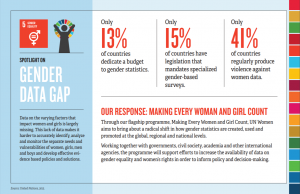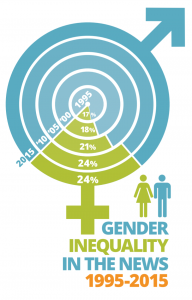Carole Sattler
The wage inequality based on different gender is well known to everyone. But what is about the “Gender Data Gap”?
To make correct conclusions about reality, accurate analyses and statistics must also be provided. The Executive Director of UN Women, Phumzile Mlambo-Ngcuka, put it succinctly: “Without quality data, there is simply no credible path to achieving the Sustainable Development Goals.” [1]
The data must reflect the lives of everyone; women, men, girls and boys. And within the gender, there should be further differentiations; pregnancy, disability, social status, educational level, etc. Unfortunately, this is not the case today. 80 % of the indicators for gender equality of the Sustainable Development Goals (SGDs) have data gaps. [2]
To promote better gender statistics for the SGDs, the flagship program “Making every Women and Girl count” was created. They aim of this program is to evoke a change in approaching, designing and publishing statistics in a sustainable way, so that the invisibility of women is reduced. In this way, the data for the SDGs are not only evaluated, but the data gap is also investigated. [3]

Figure 8.1 – Overview Gender Data Gap [3]
The gender data gap is widespread and can be found in various areas; in everyday life, in medical research, in the media or in safety measures, where for example car airbags are designed according to the male anatomy. Certain consequences of the data gaps might be unpleasant or annoying. But some can lead to serious injuries, chronic diseases or even fatalities. It is important to note, that these data gaps are not done premeditated. It was rather non-thinking than a clear intention which caused the data gaps. One can also try to explain it with history. There are always talks about hunters & gatherers, knights and the Romans. Women rarely find a place in such stories.
Because this data gap exists and we are becoming more aware of it, it is getting more and more important that we take this inequality actively into account in our daily research and statistics. [4]
Gender data gap in medicine
It is visually undeniable that the female body is different from the male body. But did you know that the cells of a woman are different from the cells of a man? According to Dr. Elizabeth Pollitzer, the concentration of metabolites in the cells is depending on gender. Another known difference between the bodies is the ability of a woman to bear a child. A woman develops an individual that lives from the resources her body provides. The logical conclusion with this knowledge is that the effect of drugs must be tested on women, taking into account a possible pregnancy. Unfortunately, this is often not the case. This is why the drug scandal of a tranquilizer containing the substance thalidomide occurred. This drug was prescribed against morning sickness for pregnant women. Although there was no dose found which killed rats, the development of the fetus was permanently affected. This fact was known to the developers one year before it was first prescribed in 1959 to pregnant women. But it was not taken off the market until 1962.
It makes you wonder how something like this could’ve happened. The answer is the Gender Data Gap. Women are underrepresented in clinical trials and significantly in Phase-I-trials. In the Phase-I-trials, the effect and possible side effects of a drug are tested and investigated with a small number of participants. In this phase, women are not sufficiently represented with just 22%. It becomes exciting when you look at the second most frequent counter-reaction of a drug by women; the non-action of the drug. These lead to the question of how many drugs are eliminated in Phase I studies that have no effect in the majority of participants, more precisely in men, but could have an effect on women? [4]
Gender data gap in daily life
There are unpleasant consequences of data gaps in the workplace, which were not taken into account during the construction of an office building. In the morning, a woman comes to work and has first to walk with her heels over the cobblestone path to the entrance door. Then she goes up the stylistic glass staircase where people can look under her skirt one floor below in the stairwell. In the day, she has to go to the toilet and barely gets into the toilet room because the door is so heavy. Unpleasant situations in everyday life. You might think that the slightly too low room temperature in the office is the same. But this can have more than just inefficiency and discomfort. Permanent freezing can lead to chronic diseases. How is such a room temperature even determined? Via a formula that takes into account a man’s metabolism and average weight. As a result, is the room temperature five degrees too cold for an average woman.
Such consequences of data gaps are not only found in the office but also in nursing. Using prejudice and claims that it still counts as a typically female profession. The everyday life of nursing professionals is physically very demanding. You have to help people out of bed, wash them, dress them and are on your feet all day. There is no upper weight limit for lifting a heavy patient. However, at a typical male profession such like on the construction there are for instance precise specifications as to when a construction worker may still lift the load and when to use a machine for the lifting. [4]
Gender data gap in the news
Where do people get their information? Where do politicians present their opinions? On the news. News includes many things; radio, television and written news such as newspapers, magazines, online articles or now also Twitter.
These news shape us, they influence our thinking and how we perceive the world. This is why the news must have gender equality. Therefore man and woman should be presented and perceived equally. [5]
The Global Media Monitoring Project (GMMP) examines exactly these incidents every 5 years. The 2020 report will be published later this year, so the data and examples are based on the 2015 report.
The GMMP examines the percentage of female representation in six main story topics in newspapers, television and radio. These main topic stories are Science & Health, Social & Legal, Crime & Violence, Economics, Politics & Government and Celebrity, Arts & Sports. The smallest difference between the male and female share is in Science & Health, where women make up 35% of the people in the news. The biggest difference is in Politics & Government, where the share of women is only 16%.
The GMMP examines not only the proportion of women in the news but also their function in the story. A distinction is made between 6 functions; personal experience, popular opinion, eye witness, subject, spokesperson, expert. The interesting thing is that the news not only represents masculinity more often but most of all a certain kind of masculinity; politicians. In the functions spokesperson, subject and experts, men and women are generally referred to as government officials or politicians. But in the other three functions, there are differences. Men are still mostly referred to as politicians, whereas women are referred to as parents/homeworkers in the function of personal experience, as residents/villagers in eyewitness and as students in popular opinion.
The GMMP not only examines the content but also the person presenting the news. There the representation is very different depending on the medium. Overall, female representation is only 37%. This is mainly caused by the newspaper, because there it is only 35%, whereas newspapers 57% and radio 41% of news are reported by women. But here again, depending on the topic, there are deficits. For example, only 31% of news about politics and 39% of news about economics are reported by women. [6]
One could now say that these percentages have been created by the gender employment percentage in the sectors. But how did these percentages come about? If the media tells the younger generations which sector is being dominated by which gender, these rates will never change. We grow up with the media, today even more than before. The news influences us, consciously and unconsciously. That is why it is important to ensure equal representation. In figure 2 you can see the development of the different shares over the years. Between 2010 and 2015 there was no change at all. [5]

Figure 8.2 – Development of women representation in the media [6]
Conclusion
There’s a gender data gap everywhere. And it is not going to go away overnight. The important thing is that we are aware of the gender data gap so that it can be avoided in the future. Statistics and analyses have to be questioned that bad consequences of the gaps can be prevented.
Filling the data gaps is essential to achieve Gender Equality which is the 5th goal of the SDGs. Only then we can make correct evaluations and trace processes. Once the gender data gaps are filled, the path is open to achieve the Sustainable Development Goals.
Sources:
[1]: UN Women. (2016). Access on March 17, 2020. Retrieved from https://www.unwomen.org/en/news/stories/2016/9/speech-by-ed-on-making-every-woman-and-girl-count
[2]: UN Women. (2016). Access on March 17, 2020. Retrieved from https://www.unwomen.org/en/how-we-work/flagship-programmes/making-every-woman-and-girl-count
[3]: UN Women. (2017). Access on March 17, 2020. Retrieved from https://www.unwomen.org/en/digital-library/multimedia/2017/7/infographic-spotlight-on-sdg-5
[4]: Criado-Perez, C. (2020). Unsichtbare Frauen: Wie eine von Daten beherrschte Welt die Hälfte der Bevölkerung ignoriert (3. Aufl.) Munich, Germany: btb.
[5]: World Association for Christian Communication (WACC). (2015). Global Media Monitoring Project 2015: Who makes the news? Access on March 17, 2020. Retrieved from http://cdn.agilitycms.com/who-makes-the-news/Imported/reports_2015/global/gmmp_global_report_en.pdf
[6]: World Accociation für Christian Communication (WACC). (2015). Global Media Monitoring Project 2015: Highlights. Access on March 17, 2020. Retrieved from http://cdn.agilitycms.com/who-makes-the-news/Imported/reports_2015/highlights/highlights_en.pdf
Media Attributions
- gender data
- daten